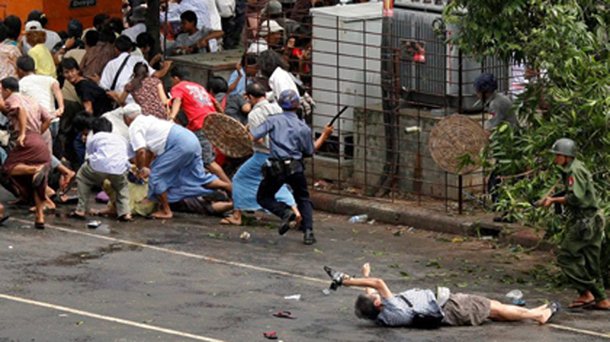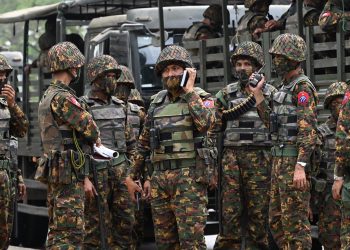Wednesday marks the 10th anniversary of the death of Japanese journalist Kenji Nagai at the hands of a Myanmar Army soldier during the country’s Saffron Revolution. The domestic upheaval became an increasingly international affair the shooting was captured on video and broadcast worldwide. Known as the Saffron Revolution, the monk-led anti-government protests of August and September 2007 were, for many people outside the country, their first exposure to the brutality of Burma’s former military regime. This story, originally published in December 2007, offers another Japanese photojournalist’s take on the death of a colleague and countryman.
JAPAN — It was painful to witness the images broadcast worldwide on Sept. 27, 2007. Japanese cameraman Kenji Nagai was lying on his back on a street in Rangoon. Then there was the piercing sound of a bullet fired from the rifle of a soldier.
Kenji Nagai, a man I considered a colleague, was dead. Immediately, I thought: It could have been me. As a photojournalist, I also report on conflicts. I have covered many Asian countries, including Burma, and I imagined myself in Kenji Nagai’s place, lying dead on a street in Rangoon.
But, I was in Japan, and he was in Rangoon. However, I knew the streets where the pro-democracy demonstrations occurred—the scene was very familiar to me.
For me, the shooting confirmed the true mentality of the Burmese junta, which has been killing and imprisoning the Burmese people with impunity for decades: 3,000 or more people died in 1988 alone, the year I started covering events in Burma.
On the day Kenji Nagai was murdered, I was taking photographs of exiled Burmese activists who were demonstrating in front of the Burmese Embassy in Tokyo, demanding the Japanese government stop supporting the State Peace and Development Council financially.
Later that day, my mobile phone started ringing, one call after another without a break. News agencies and newspapers were calling me to check if the unidentified Japanese journalist killed in Rangoon was me or not. One call was from Australia, from my Burmese friend who had worked as my interpreter when I made trips to Burma. He explained that he was worried about me when he heard the news.
Before long, the Japanese media confirmed the dead journalist was Kenji Nagai. His name was new to me, and we had never met.
The TV news showed video of the shooting of Kenji Nagai over and over again for several days. The Japanese public was horrified and angry. The Japanese government seemed shocked. Perhaps for the first time, the government realized the SPDC is truly an evil government.
When the funeral service was held on Oct. 8 in Tokyo, hundreds of Burmese exiles attended the service to honor Kenji Nagai. They apologized for his death on behalf of the SPDC government, which they hate. It was a natural feeling for the Burmese people who live in Japan to express their sorrow for Kenji Nagai, who was now a martyr in the Burmese struggle for democracy.
Media coverage on Kenji Nagai focused on his personality, his professional work in Iraq and elsewhere, but neglected any factual background on what had been happening in Burma under the military regime for the past 20 years. There were almost no critical questions about Japan’s foreign policy toward the military junta—whether it was trying to help the country move toward democracy or helping the SPDC.
As a photojournalist, I have been critical of Japan’s foreign policy, which has favored the SPDC generals rather than the democratic forces and the ethnic minorities. You can get a sense of Japan’s policy toward the SPDC through various comments made by top Japanese diplomats.
For instance, the then Foreign Minister Yoriko Kawaguchi made an ignorant comment in May 2003, when she was asked about the murderous attack on Aung San Suu Kyi’s motorcade at Depayin. She said, “There is no deterioration of environment for dialogue between the SPDC and Aung San Suu Kyi.” She retracted her comment the next day.
In May 2006, Japanese ambassador to the United Nations, Kenzo Oshima, said, “Burma does not constitute a regional threat yet,” and along with China and Russia, Japan opposed efforts by the United States and European Union to put Burma on the Security Council agenda.
The latest and most shameless comment was made by Yoichi Yamaguchi, the former Japanese ambassador to Burma (1995-97).
After the killing of Nagai, he was quoted in the Japanese media as saying several offensive comments:
“Aung San Suu Kyi’s National League for Democracy gave money to the demonstrators.”
“There is not a single so-called political prisoner there [in Burma] in the true sense.”
“The regime has succeeded in maintaining economic growth of over 5 percent annually, earning it the widespread trust of the people.”
After Kenji Nagai’s death, the Japanese government took a seemingly strong stance. In New York, Foreign Minister Komura demanded an apology from the SPDC. But as time passed and the crackdown by security forces continued, the Japanese government remained quiet, simply waiting for the UN Security Council to act.
“The government will coordinate efforts with the United Nations and the Association of Southeast Asian Nations to make progress in the democratization of Myanmar [Burma],” Komura said after the UNSC’s presidential statement was announced.
Later, Japan cancelled a grant of up to 552 million yen (US $4.7 million). The grant had been intended to finance the construction of a human resources center.
On Oct. 28, the People’s Forum on Burma, an NGO formed in Tokyo in 1996 to support the Burmese people’s struggle for democracy, made a plea for the Japanese government to fundamentally change its foreign policy toward the SPDC by giving full-scale humanitarian support to the 160,000 displaced people in refugee camps in Thailand.
The group also asked for a halt in grants to the Union Solidarity and Development Association, which was accused of taking part in the suppression of the demonstrators. In 2006, the USDA received a Japanese grant of nearly 24 million yen ($209,000) for construction of three grade school buildings. It also demanded that Japan stop humanitarian aid to subsidize Burma’s health care and education budgets while the military regime allocates more than 50 percent of its national budget on the military.
The group wants to pressure the Japanese government to support the Burmese people and the pro-democracy groups, instead of helping to keep the generals in power.
A Burmese citizen in Tokyo, a former political prisoner, said Burmese exiles remember two Japanese citizens: one with hate, and one with great respect.
One is former ambassador Yoichi Yamaguchi; the other is journalist Kenji Nagai.
Yamamoto Munesuke’s books include “Burma’s Children” and “Burma’s Great Illusions.” He was deported from Burma in 1998 “for gathering news,” following his exclusive interview with Aung San Suu Kyi.











